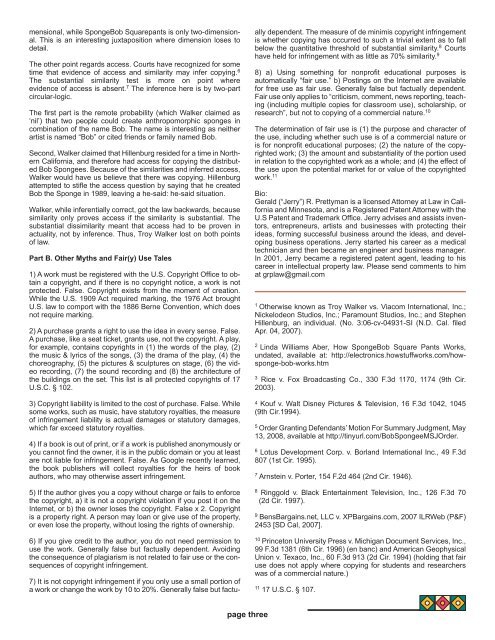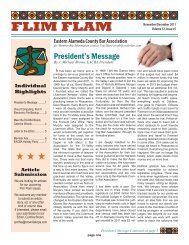FLIM FLAM - GRPLAW Law Office of Gerald R. Prettyman
FLIM FLAM - GRPLAW Law Office of Gerald R. Prettyman
FLIM FLAM - GRPLAW Law Office of Gerald R. Prettyman
You also want an ePaper? Increase the reach of your titles
YUMPU automatically turns print PDFs into web optimized ePapers that Google loves.
mensional, while SpongeBob Squarepants is only two-dimensional.<br />
This is an interesting juxtaposition where dimension loses to<br />
detail.<br />
The other point regards access. Courts have recognized for some<br />
time that evidence <strong>of</strong> access and similarity may infer copying. 6<br />
The substantial similarity test is more on point where<br />
evidence <strong>of</strong> access is absent. 7 The inference here is by two-part<br />
circular-logic.<br />
The first part is the remote probability (which Walker claimed as<br />
‘nil’) that two people could create anthropomorphic sponges in<br />
combination <strong>of</strong> the name Bob. The name is interesting as neither<br />
artist is named “Bob” or cited friends or family named Bob.<br />
Second, Walker claimed that Hillenburg resided for a time in Northern<br />
California, and therefore had access for copying the distributed<br />
Bob Spongees. Because <strong>of</strong> the similarities and inferred access,<br />
Walker would have us believe that there was copying. Hillenburg<br />
attempted to stifle the access question by saying that he created<br />
Bob the Sponge in 1989, leaving a he-said: he-said situation.<br />
Walker, while inferentially correct, got the law backwards, because<br />
similarity only proves access if the similarity is substantial. The<br />
substantial dissimilarity meant that access had to be proven in<br />
actuality, not by inference. Thus, Troy Walker lost on both points<br />
<strong>of</strong> law.<br />
Part B. Other Myths and Fair(y) Use Tales<br />
1) A work must be registered with the U.S. Copyright <strong>Office</strong> to obtain<br />
a copyright, and if there is no copyright notice, a work is not<br />
protected. False. Copyright exists from the moment <strong>of</strong> creation.<br />
While the U.S. 1909 Act required marking, the 1976 Act brought<br />
U.S. law to comport with the 1886 Berne Convention, which does<br />
not require marking.<br />
2) A purchase grants a right to use the idea in every sense. False.<br />
A purchase, like a seat ticket, grants use, not the copyright. A play,<br />
for example, contains copyrights in (1) the words <strong>of</strong> the play, (2)<br />
the music & lyrics <strong>of</strong> the songs, (3) the drama <strong>of</strong> the play, (4) the<br />
choreography, (5) the pictures & sculptures on stage, (6) the video<br />
recording, (7) the sound recording and (8) the architecture <strong>of</strong><br />
the buildings on the set. This list is all protected copyrights <strong>of</strong> 17<br />
U.S.C. § 102.<br />
3) Copyright liability is limited to the cost <strong>of</strong> purchase. False. While<br />
some works, such as music, have statutory royalties, the measure<br />
<strong>of</strong> infringement liability is actual damages or statutory damages,<br />
which far exceed statutory royalties.<br />
4) If a book is out <strong>of</strong> print, or if a work is published anonymously or<br />
you cannot find the owner, it is in the public domain or you at least<br />
are not liable for infringement. False. As Google recently learned,<br />
the book publishers will collect royalties for the heirs <strong>of</strong> book<br />
authors, who may otherwise assert infringement.<br />
5) If the author gives you a copy without charge or fails to enforce<br />
the copyright, a) it is not a copyright violation if you post it on the<br />
Internet, or b) the owner loses the copyright. False x 2. Copyright<br />
is a property right. A person may loan or give use <strong>of</strong> the property,<br />
or even lose the property, without losing the rights <strong>of</strong> ownership.<br />
6) If you give credit to the author, you do not need permission to<br />
use the work. Generally false but factually dependent. Avoiding<br />
the consequence <strong>of</strong> plagiarism is not related to fair use or the consequences<br />
<strong>of</strong> copyright infringement.<br />
7) It is not copyright infringement if you only use a small portion <strong>of</strong><br />
a work or change the work by 10 to 20%. Generally false but factu-<br />
page three<br />
ally dependent. The measure <strong>of</strong> de minimis copyright infringement<br />
is whether copying has occurred to such a trivial extent as to fall<br />
below the quantitative threshold <strong>of</strong> substantial similarity. 8 Courts<br />
have held for infringement with as little as 70% similarity. 9<br />
8) a) Using something for nonpr<strong>of</strong>it educational purposes is<br />
automatically “fair use.” b) Postings on the Internet are available<br />
for free use as fair use. Generally false but factually dependent.<br />
Fair use only applies to “criticism, comment, news reporting, teaching<br />
(including multiple copies for classroom use), scholarship, or<br />
research”, but not to copying <strong>of</strong> a commercial nature. 10<br />
The determination <strong>of</strong> fair use is (1) the purpose and character <strong>of</strong><br />
the use, including whether such use is <strong>of</strong> a commercial nature or<br />
is for nonpr<strong>of</strong>it educational purposes; (2) the nature <strong>of</strong> the copyrighted<br />
work; (3) the amount and substantiality <strong>of</strong> the portion used<br />
in relation to the copyrighted work as a whole; and (4) the effect <strong>of</strong><br />
the use upon the potential market for or value <strong>of</strong> the copyrighted<br />
work. 11<br />
Bio:<br />
<strong>Gerald</strong> (“Jerry”) R. <strong>Prettyman</strong> is a licensed Attorney at <strong>Law</strong> in California<br />
and Minnesota, and is a Registered Patent Attorney with the<br />
U.S Patent and Trademark <strong>Office</strong>. Jerry advises and assists inventors,<br />
entrepreneurs, artists and businesses with protecting their<br />
ideas, forming successful business around the ideas, and developing<br />
business operations. Jerry started his career as a medical<br />
technician and then became an engineer and business manager.<br />
In 2001, Jerry became a registered patent agent, leading to his<br />
career in intellectual property law. Please send comments to him<br />
at grplaw@gmail.com<br />
1 Otherwise known as Troy Walker vs. Viacom International, Inc.;<br />
Nickelodeon Studios, Inc.; Paramount Studios, Inc.; and Stephen<br />
Hillenburg, an individual. (No. 3:06-cv-04931-SI (N.D. Cal. filed<br />
Apr. 04, 2007).<br />
2 Linda Williams Aber, How SpongeBob Square Pants Works,<br />
undated, available at: http://electronics.howstuffworks.com/howsponge-bob-works.htm<br />
3 Rice v. Fox Broadcasting Co., 330 F.3d 1170, 1174 (9th Cir.<br />
2003).<br />
4 Kouf v. Walt Disney Pictures & Television, 16 F.3d 1042, 1045<br />
(9th Cir.1994).<br />
5 Order Granting Defendants’ Motion For Summary Judgment, May<br />
13, 2008, available at http://tinyurl.com/BobSpongeeMSJOrder.<br />
6 Lotus Development Corp. v. Borland International Inc., 49 F.3d<br />
807 (1st Cir. 1995).<br />
7 Arnstein v. Porter, 154 F.2d 464 (2nd Cir. 1946).<br />
8 Ringgold v. Black Entertainment Television, Inc., 126 F.3d 70<br />
(2d Cir. 1997).<br />
9 BensBargains.net, LLC v. XPBargains.com, 2007 ILRWeb (P&F)<br />
2453 [SD Cal, 2007].<br />
10 Princeton University Press v. Michigan Document Services, Inc.,<br />
99 F.3d 1381 (6th Cir. 1996) (en banc) and American Geophysical<br />
Union v. Texaco, Inc., 60 F.3d 913 (2d Cir. 1994) (holding that fair<br />
use does not apply where copying for students and researchers<br />
was <strong>of</strong> a commercial nature.)<br />
11 17 U.S.C. § 107.



